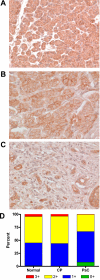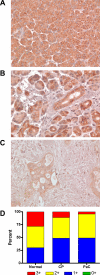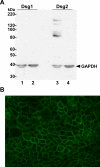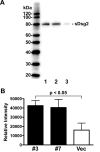Desmoglein 2 is a substrate of kallikrein 7 in pancreatic cancer
- PMID: 19091121
- PMCID: PMC2628383
- DOI: 10.1186/1471-2407-8-373
Desmoglein 2 is a substrate of kallikrein 7 in pancreatic cancer
Abstract
Background: In a previous report we have demonstrated that the chymotryptic-like serine protease kallikrein 7 (KLK7/hK7) is overexpressed in pancreatic cancer. In normal skin, hK7 is thought to participate in skin desquamation by contributing in the degradation of desmosomal components, such as desmogleins. Thus, the ability of hK7 to degrade desmogleins was assessed and the effect of hK7 expression on desmoglein 2 was examined in cultured pancreatic cancer cells.
Methods: The expression of Dsg1, Dsg2, and Dsg3 in pancreatic tissues was examined by immunohistochemistry and their expression in two pancreatic cancer cell lines, BxPC-3 and Panc-1, was determined by western blot analysis. The ability of hK7 to degrade Dsg1 and Dsg2 was investigated using in vitro degradation assays. BxPC-3 cells stably transfected to overexpress hK7 were used to examine the effect of hK7 on cell-surface resident Dsg2.
Results: The levels of immunoreactive Dsg1 and Dsg2 were reduced in pancreatic adenocarcinomas compared with both normal pancreatic and chronic pancreatitis tissues. Among the desmosomal proteins examined, Dsg2 exhibited robust expression on the surface of BxPC-3 cells. When hK7 was overexpressed in this cell line, there was a significant increase in the amount of soluble Dsg2 released into the culture medium compared with vector-transfected control cells.
Conclusion: A reduction in the amount of the cell adhesion components Dsg1 and Dsg2 in pancreatic tumors suggests that loss of these desmosomal proteins may play a role in pancreatic cancer invasion. Using in vitro degradation assays, both Dsg1 and Dsg2 could be readily proteolyzed by hK7, which is overexpressed in pancreatic adenocarcinomas. The enforced expression of hK7 in BxPC-3 cells that express significant amounts of Dsg2 resulted in a marked increase in the shedding of soluble Dsg2, which is consistent with the notion that aberrant expression of hK7 in pancreatic tumors may result in diminished cell-cell adhesion and facilitate tumor cell invasion.
Figures





Similar articles
-
Kallikrein 7 enhances pancreatic cancer cell invasion by shedding E-cadherin.Cancer. 2007 May 1;109(9):1811-20. doi: 10.1002/cncr.22606. Cancer. 2007. PMID: 17354228
-
Expression of desmogleins 1-3 and their clinical impacts on human lung cancer.Pathol Res Pract. 2015 Mar;211(3):208-13. doi: 10.1016/j.prp.2014.10.008. Epub 2014 Oct 31. Pathol Res Pract. 2015. PMID: 25468811
-
Desmogleins as prognostic biomarkers in resected pancreatic ductal adenocarcinoma.Br J Cancer. 2015 Nov 17;113(10):1460-6. doi: 10.1038/bjc.2015.362. Epub 2015 Oct 15. Br J Cancer. 2015. PMID: 26469831 Free PMC article.
-
Targeting kallikrein proteases for dandruff therapy.Acta Dermatovenerol Alp Pannonica Adriat. 2024 Dec;33(4):171-176. Acta Dermatovenerol Alp Pannonica Adriat. 2024. PMID: 39707892 Review.
-
Desmoglein-2 as a cancer modulator: friend or foe?Front Oncol. 2023 Dec 22;13:1327478. doi: 10.3389/fonc.2023.1327478. eCollection 2023. Front Oncol. 2023. PMID: 38188287 Free PMC article. Review.
Cited by
-
Characterization of desmoglein 2 expression in ovarian serous tumors and its prognostic significance in high-grade serous carcinoma.Int J Clin Exp Pathol. 2018 Oct 1;11(10):4977-4986. eCollection 2018. Int J Clin Exp Pathol. 2018. PMID: 31949574 Free PMC article.
-
Telomere-related prognostic biomarkers for survival assessments in pancreatic cancer.Sci Rep. 2023 Jun 30;13(1):10586. doi: 10.1038/s41598-023-37836-0. Sci Rep. 2023. PMID: 37391503 Free PMC article.
-
Genetic activation of Nrf2 reduces cutaneous symptoms in a murine model of Netherton syndrome.Dis Model Mech. 2020 Jun 1;13(5):dmm042648. doi: 10.1242/dmm.042648. Dis Model Mech. 2020. PMID: 32457102 Free PMC article.
-
KLK7 expression in human tumors: a tissue microarray study on 13,447 tumors.BMC Cancer. 2024 Jul 3;24(1):794. doi: 10.1186/s12885-024-12552-8. BMC Cancer. 2024. PMID: 38961454 Free PMC article.
-
The substrate degradome of meprin metalloproteases reveals an unexpected proteolytic link between meprin β and ADAM10.Cell Mol Life Sci. 2013 Jan;70(2):309-33. doi: 10.1007/s00018-012-1106-2. Epub 2012 Sep 1. Cell Mol Life Sci. 2013. PMID: 22940918 Free PMC article.
References
-
- Hanahan D, Weinberg RA. The hallmarks of cancer. Cell. 2000;100:57–70. - PubMed
-
- Zetter BR. Adhesion molecules in tumor metastasis. Semin Cancer Biol. 1993;4:219–229. - PubMed
-
- Green KJ, Gaudry CA. Are desmosomes more than tethers for intermediate filaments? Nat Rev Mol Cell Biol. 2000;1:208–216. - PubMed
-
- Kowalczyk AP, Bornslaeger EA, Norvell SM, Palka HL, Green KJ. Desmosomes: intercellular adhesive junctions specialized for attachment of intermediate filaments. Int Rev Cytol. 1999;185:237–302. - PubMed
Publication types
MeSH terms
Substances
LinkOut - more resources
Full Text Sources
Other Literature Sources
Medical
Miscellaneous

